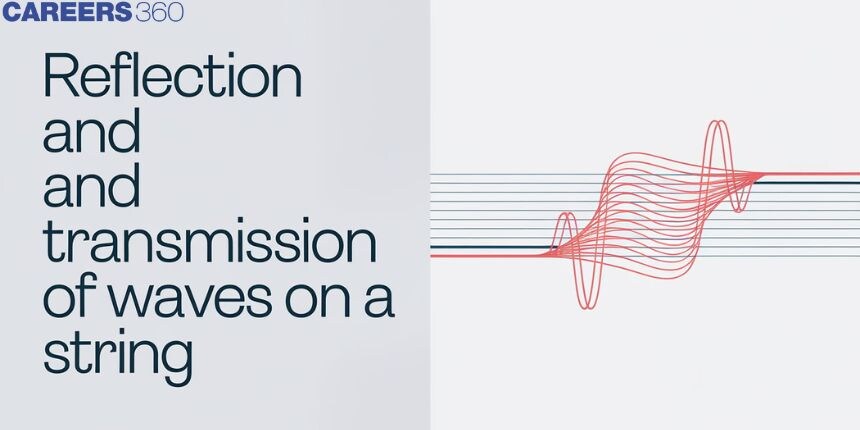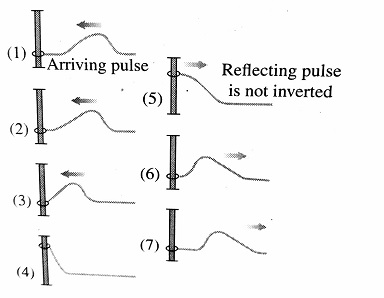Reflection And Transmission Of Waves On A String
When a wave travels along a string, its behaviour changes when it encounters a boundary or an obstacle. This phenomenon, known as the reflection and transmission of waves on a string, is crucial for understanding wave mechanics. Imagine plucking a guitar string: the vibrations you see are waves travelling back and forth along the string. When these waves hit the ends of the string, they either reflect back or transmit energy into another medium, like the body of the guitar, producing sound. In real life, similar principles apply to seismic waves during an earthquake, where waves reflect and transmit through different layers of the Earth, influencing the magnitude and impact of the quake. In this article, we will understand these wave behaviours not only deepens our grasp of physics but also has practical implications in engineering, music, and geology.
This Story also Contains
- Reflection and Transmission of Waves on a String
- Boundary Conditions
- Assuming no transmission, no absorption and energy lost when a wave hits the boundary.
- Wave in a Combination of String
- Solved Examples Based on Reflection and Transmission of Waves on a String
- Summary

Reflection and Transmission of Waves on a String
When a wave travels along a string and encounters a point of discontinuity, such as a change in the string's thickness or tension, it undergoes reflection and transmission. In simpler terms, part of the wave's energy is reflected back along the string, while the rest continues to travel through the new medium. This process is akin to what happens when you pluck a guitar string: the vibrations, or waves, move along the string, reflect at the ends, and transmit energy to produce sound. When waves are incident on a boundary between two media a part of incident waves returns back into the initial medium ( reflection ) while the remaining is partly absorbed and partly transmitted into the second medium ( refraction ).
Boundary Conditions
Assuming no transmission, no absorption and energy lost when a wave hits the boundary.
1. Rigid end
when the incident wave reaches a fixed end, it exerts an upward pull on the end, according to Newton's 3rd law at a fixed end it exerts an equal and opposite downward force on the string. It results in an inverted pulse or phase change of
Crest (C) reflects as a trough(T) and vice-versa, Time changes by

2) Free End
when a wave or pulse is reflected from a free end, then there is no change of phase (as there is no reaction force).
crest (C) reflects as the crest (C) and trough (T) reflects as a trough(T), Time changes by zero and path changes by zero.
Wave in a Combination of String
1. Wave goes from rarer to a denser medium

2. Wave goes from denser to rarer medium

The Amplitude of Reflected Wave
If
Where
Or we can write
Where
Amplitude of transmitted wave
If the amplitude of the transmitted wave then
Where
Or we can write
Where
Solved Examples Based on Reflection and Transmission of Waves on a String
Example 1: A wave is reflected from a rigid support. The change in phase on reflection will be
1)
2)
3)
4)
Solution:
Reflection of wave-fixed end
1) There is a phase change for the reflected wave

2) At the boundary, some or all of the waves are reflected.
3) When it is reflected from a fixed end, the wave is inverted.
After reflection from rigid support, a wave suffers a phase change of
Hence, the answer is the option (3).
Example 2: A string of length 20 cm and linear mass density 0.40 g/cm is fixed at both ends and kept under tension 16N. A pulse at t=0 near one end occurs while travelling towards the other end. When will it have the same shape (time in seconds)

1) 0.02
2) 2
3) 0.01
4) 0.4
Solution:
The velocity of the wave,
$\therefore$ Time taken to reach the other end =20 / 2000=0.01 sec
Total time is taken to see the pulse again in the original position =0.01 x 2=0.02 sec
Hence, the answer is the option (1).
Example 3: To decrease the fundamental frequency of stretched string at both ends one might
1) Increase Tension
2) Increase Wave velocity
3) Increase Length
4) Decrease Liner momentum
Solution:
Reflection of wave-free end
1) If the end of the string is free to move vertically, the free end overshoots twice the amplitude.
2) At the boundary all or part of it is reflected.
3) When reflected from the free end, the pulse is not inverted.

After increasing length freq. decreases
Hence, the answer is the option (3).
Example 4: What is the value of phase change when a transverse wave strikes the free end?
1) 0o
2) 90o
3) 180o
4) 270o
Solution:
When the incident wave reaches a free end, it exerts an upward pull on the free end as there is no opposition, the crest returns as a crest or trough return as a trough.
Hence, the answer is the option (1).
Example 5: What is the value of phase change when a transverse wave pulse is reflected by the free end?
1) 0o
2) 90o
3) 180o
4) 270o
Solution:
When a transverse wave or pulse is reflected from a free end, then there is no change of phase (as there is no reaction force).
Hence, the answer is the option (1).
Summary
The reflection and transmission of waves on a string occur when a wave encounters a boundary or discontinuity, leading to the division of energy between reflected and transmitted waves. The behaviour of these waves depends on the boundary conditions, such as whether the end is rigid or free. The amplitude and phase change of the reflected and transmitted waves are governed by the properties of the string and the medium it interacts with.
